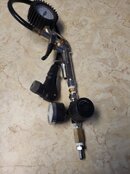I’d like to reduce the IP of some MK2 style piston first stages down to 7.5bar. This is for drysuit inflation and booster pump drive gas, not for second stage.
I’ve removed all the shims but this only brings the IP down to 9bar, is there a way to further reduce IP? Perhaps grinding down the spring, or not fully screw in the spring cap?
I’ve removed all the shims but this only brings the IP down to 9bar, is there a way to further reduce IP? Perhaps grinding down the spring, or not fully screw in the spring cap?




